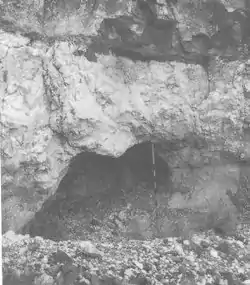Burro Mesa Archeological District | |
 | |
| Location | Address restricted[1] |
|---|---|
| Nearest city | Panther Junction, Texas |
| Area | 260 acres (110 ha) |
| NRHP reference No. | 85002309[2] |
| Added to NRHP | September 11, 1985 |
The Burro Mesa Archeological District encompasses a quarry in Big Bend National Park used by Native Americans as a source of chert for chipped-stone tools. The quarry was used intermittently beginning in the paleoindian period starting about 12,000 to 13,000 years ago. The chert is found in a variety of colors and rests on top of tuff beds which themselves contain veins of kaolinite that was suitable for making claystone ornaments and beads. The quarry area is carpeted with lithic debris from the initial knapping process by which chert was rough-shaped into material of suitable size and shape for later refinement at more convenient locations.[3]
The quarry was placed on the National Register of Historic Places on September 11, 1985.[2]
See also
References
- ↑ Federal and state laws and practices restrict general public access to information regarding the specific location of this resource. In some cases, this is to protect archeological sites from vandalism, while in other cases it is restricted at the request of the owner. See: Knoerl, John; Miller, Diane; Shrimpton, Rebecca H. (1990), Guidelines for Restricting Information about Historic and Prehistoric Resources, National Register Bulletin, National Park Service, U.S. Department of the Interior, OCLC 20706997.
- 1 2 "National Register Information System". National Register of Historic Places. National Park Service. July 9, 2010.
- ↑ "Burro Mesa Chert and Kaolinite". Texas Beyond History. Texas Archeological Research Laboratory.
Wikimedia Commons has media related to Burro Mesa Archeological District.
This article is issued from Wikipedia. The text is licensed under Creative Commons - Attribution - Sharealike. Additional terms may apply for the media files.
